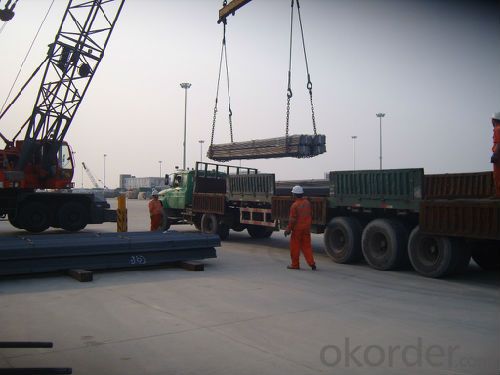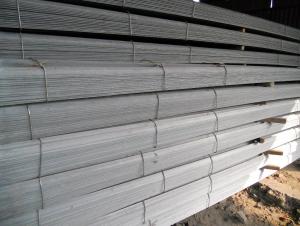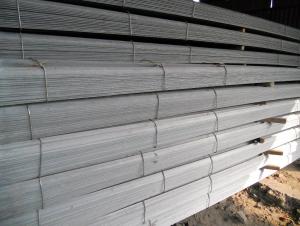Low Carbon Prime Steel Equal Angle Bars in High Quality
- Loading Port:
- Tianjin
- Payment Terms:
- TT or LC
- Min Order Qty:
- 100 m.t.
- Supply Capability:
- 20000 m.t./month
OKorder Service Pledge
OKorder Financial Service
You Might Also Like
OKorder is offering Low Carbon Prime Steel Equal Angle Bars in High Quality at great prices with worldwide shipping. Our supplier is a world-class manufacturer of steel, with our products utilized the world over. OKorder annually supplies products to African, South American and Asian markets. We provide quotations within 24 hours of receiving an inquiry and guarantee competitive prices.
Product Applications:
Low Carbon Prime Steel Equal Angle Bars in High Quality are ideal for structural applications and are widely used in the construction of buildings and bridges, and the manufacturing, petrochemical, and transportation industries
Product Advantages:
OKorder's Low Carbon Prime Steel Equal Angle Bars in High Quality are durable, strong, and wide variety of sizes.
Main Product Features:
· Premium quality
· Prompt delivery & seaworthy packing (30 days after receiving deposit)
· Can be recycled and reused
· Mill test certification
· Professional Service
· Competitive pricing
Product Specifications:
Manufacture: Hot rolled
Grade: Q195 – 235
Certificates: ISO, SGS, BV, CIQ
Length: 6m – 12m, as per customer request
Packaging: Export packing, nude packing, bundled
| EQUAL ANGLE STEEL | |||||
| size(mm) | a(mm) | a1(mm) | thickness(mm) | kg/m | length |
| 50*50*4 | 50 | 50 | 4 | 3.059 | 6m,9m,12m |
| 50*50*5 | 50 | 50 | 5 | 3.77 | 6m,9m,12m |
| 50*50*6 | 50 | 50 | 6 | 4.465 | 6m,9m,12m |
| 63*63*5 | 63 | 63 | 5 | 4.822 | 6m,9m,12m |
| 63*63*6 | 63 | 63 | 6 | 5.721 | 6m,9m,12m |
| 65*65*5 | 65 | 65 | 5 | 5 | 6m,9m,12m |
| 65*65*6 | 65 | 65 | 6 | 5.91 | 6m,9m,12m |
| 65*65*8 | 65 | 65 | 8 | 7.66 | 6m,9m,12m |
| 75*75*5 | 75 | 75 | 5 | 5.818 | 6m,9m,12m |
| 75*75*6 | 75 | 75 | 6 | 6.905 | 6m,9m,12m |
| 75*75*8 | 75 | 75 | 8 | 9.03 | 6m,9m,12m |
| 75*75*9 | 75 | 75 | 9 | 9.96 | 6m,9m,12m |
| 75*75*10 | 75 | 75 | 10 | 11.089 | 6m,9m,12m |
| 80*80*6 | 80 | 80 | 6 | 7.375 | 6m,9m,12m |
| 80*80*7 | 80 | 80 | 7 | 8.525 | 6m,9m,12m |
| 80*80*8 | 80 | 80 | 8 | 9.658 | 6m,9m,12m |
| 80*80*10 | 80 | 80 | 10 | 11.874 | 6m,9m,12m |
| 90*90*6 | 90 | 90 | 6 | 8.35 | 6m,9m,12m |
| 90*90*7 | 90 | 90 | 7 | 9.656 | 6m,9m,12m |
| 90*90*8 | 90 | 90 | 8 | 10.946 | 6m,9m,12m |
| 90*90*10 | 90 | 90 | 10 | 13.476 | 6m,9m,12m |
| 100*100*6 | 100 | 100 | 6 | 9.366 | 6m,9m,12m |
| 100*100*7 | 100 | 100 | 7 | 10.83 | 6m,9m,12m |
| 100*100*8 | 100 | 100 | 8 | 12.276 | 6m,9m,12m |
| 100*100*9 | 100 | 100 | 9 | 13.49 | 6m,9m,12m |
| 100*100*10 | 100 | 100 | 10 | 15.12 | 6m,9m,12m |
| 100*100*12 | 100 | 100 | 12 | 17.898 | 6m,9m,12m |
| 120*120*8 | 120 | 120 | 8 | 14.88 | 6m,9m,12m |
| 120*120*10 | 120 | 120 | 10 | 18.37 | 6m,9m,12m |
| 120*120*12 | 120 | 120 | 12 | 21.66 | 6m,9m,12m |
| 125*125*8 | 125 | 125 | 8 | 15.504 | 6m,9m,12m |
| 125*125*10 | 125 | 125 | 10 | 19.133 | 6m,9m,12m |
| 125*125*12 | 125 | 125 | 12 | 22.696 | 6m,9m,12m |
| 130*130*10 | 130 | 130 | 10 | 19.8 | 6m,9m,12m |
| 130*130*12 | 130 | 130 | 12 | 23.6 | 6m,9m,12m |
| 130*130*13 | 130 | 130 | 13 | 25.4 | 6m,9m,12m |
| 130*130*14 | 130 | 130 | 14 | 27.2 | 6m,9m,12m |
| 150*150*10 | 150 | 150 | 10 | 23 | 6m,9m,12m |
| 150*150*12 | 150 | 150 | 12 | 27.3 | 6m,9m,12m |
| 150*150*14 | 150 | 150 | 14 | 31.6 | 6m,9m,12m |
| 150*150*15 | 150 | 150 | 15 | 33.8 | 6m,9m,12m |
| 140*140*10 | 140 | 140 | 10 | 21.49 | 6m,9m,12m |
| 140*140*12 | 140 | 140 | 12 | 25.52 | 6m,9m,12m |
| 140*140*14 | 140 | 140 | 14 | 29.49 | 6m,9m,12m |
| 160*160*10 | 160 | 160 | 10 | 24.73 | 6m,9m,12m |
| 160*160*12 | 160 | 160 | 12 | 29.39 | 6m,9m,12m |
| 160*160*14 | 160 | 160 | 14 | 33.99 | 6m,9m,12m |
| 180*180*12 | 180 | 180 | 12 | 33.16 | 6m,9m,12m |
| 180*180*14 | 180 | 180 | 14 | 39.39 | 6m,9m,12m |
| 180*180*16 | 180 | 180 | 16 | 43.45 | 6m,9m,12m |
| 180*180*18 | 180 | 180 | 18 | 48.63 | 6m,9m,12m |
| 200*200*14 | 200 | 200 | 14 | 42.89 | 6m,9m,12m |
| 200*200*16 | 200 | 200 | 16 | 48.68 | 6m,9m,12m |
| 200*200*18 | 200 | 200 | 18 | 54.4 | 6m,9m,12m |
| 200*200*20 | 200 | 200 | 20 | 60.06 | 6m,9m,12m |
| 200*200*24 | 200 | 200 | 24 | 71.17 | 6m,9m,12m |
FAQ:
Q1: Why buy Materials & Equipment from OKorder.com?
A1: All products offered byOKorder.com are carefully selected from China's most reliable manufacturing enterprises. Through its ISO certifications, OKorder.com adheres to the highest standards and a commitment to supply chain safety and customer satisfaction.
Q2: How do we guarantee the quality of our products?
A2: We have established an advanced quality management system which conducts strict quality tests at every step, from raw materials to the final product. At the same time, we provide extensive follow-up service assurances as required.
Q3: How many tons of steel products could be loaded in containers?
A3: Usually the steel products are delivered by bulk vessel because of the large quantity and the freight. However, there are no bulk vessel enter some seaports so that we have to deliver the cargo by containers. The 6m steel product can be loaded in 20FT container, but the quantity is changed according to the size, usually from 18tons to 25tons.
Images:



- Q:What are the different types of steel angles used in shelving units?
- There are several different types of steel angles that are commonly used in shelving units. Some of the most common types include: 1. L-shaped angles: These are the most basic type of steel angles used in shelving units. They have a 90-degree angle and are commonly used to create the frame of the shelving unit. 2. Slotted angles: Slotted angles are similar to L-shaped angles but have holes or slots along their length. These holes allow for easy adjustment of the shelving height and allow for flexibility in configuring the shelving unit. 3. Equal angles: Equal angles have equal length legs and are commonly used in shelving units where the shelves are made of steel or other heavy materials. These angles provide additional strength and support to the shelves. 4. Unequal angles: Unequal angles have legs of different lengths. They are often used in shelving units where the shelves are made of lighter materials such as wood or plastic. The unequal angles provide stability and prevent the shelves from sagging under the weight of the items placed on them. 5. Slotted equal angles: Slotted equal angles are similar to slotted angles but have equal length legs. These angles are commonly used in shelving units where adjustability is required, but the added strength of equal angles is also needed. Overall, the choice of steel angles for shelving units depends on the specific requirements of the unit, such as load capacity, adjustability, and material used for the shelves.
- Q:Can steel angles be bolted together?
- Indeed, it is possible to bolt steel angles together. Steel angles find frequent application in construction and fabrication endeavors, and bolting emerges as a prevalent technique for their connection. By bolting steel angles together, a robust and reliable linkage is achieved, capable of enduring substantial loads and forces. Typically, the angles are drilled with holes at designated intervals, through which bolts are inserted and secured with nuts, thereby fastening the angles together. This approach facilitates effortless disassembly and reassembly when necessary, rendering it a versatile and pragmatic option for joining steel angles.
- Q:Can steel angles be used for reinforcing steel structures?
- Yes, steel angles can be used for reinforcing steel structures. Steel angles are versatile and widely used in construction projects for their strength and durability. They can be used as reinforcements to strengthen and provide additional support to steel structures such as beams, columns, and trusses. Steel angles are often used in conjunction with other reinforcing materials, such as steel bars or mesh, to enhance the overall structural integrity of the steel structure. The angle shape of the steel angles allows them to be easily welded or bolted into place, making them a popular choice for reinforcing steel structures. Additionally, steel angles come in various sizes and thicknesses, allowing for flexibility in design and application. Overall, steel angles are an effective and commonly used option for reinforcing steel structures.
- Q:How do you maintain and clean steel angles?
- To maintain and clean steel angles, there are a few simple steps you can follow. First, it is important to regularly inspect the angles for any signs of damage or corrosion. If any issues are identified, they should be addressed promptly to prevent further damage. To clean steel angles, start by removing any loose dirt or debris using a soft brush or cloth. This will help prevent scratching the surface. Next, you can use a mild detergent or soap mixed with warm water to clean the angles. Apply the solution using a sponge or cloth, and gently scrub the surface. Avoid using abrasive cleaners or scrub brushes, as they can damage the steel. After cleaning, rinse the angles thoroughly with clean water to remove any soap residue. Make sure to dry the angles completely to prevent water spots or rust formation. You can use a clean cloth or towel for drying, or allow them to air dry. To maintain the steel angles, it is advisable to apply a protective coating or wax. This will help prevent corrosion and maintain their appearance. There are various types of protective coatings available, such as clear lacquers or metal-specific coatings. Follow the manufacturer's instructions for application and reapplication as needed. Additionally, it is important to avoid exposing steel angles to harsh chemicals or environments that can accelerate corrosion. If the angles are located in an area with high humidity or saltwater exposure, regular maintenance and inspection become even more crucial. Overall, routine cleaning, inspection, and proper maintenance will help ensure the longevity and appearance of steel angles.
- Q:Can steel angles be used in telecommunications or broadcasting structures?
- Yes, steel angles can certainly be used in telecommunications or broadcasting structures. Steel angles provide structural support and stability, making them ideal for constructing towers, antennas, and other infrastructure required for telecommunications and broadcasting purposes.
- Q:What are the common standards and specifications for steel angles?
- The common standards and specifications for steel angles vary depending on the application and the country in which they are being used. However, some widely recognized standards and specifications include: 1. ASTM A36/A36M: This is a standard specification for carbon structural steel, including steel angles. It covers shapes such as angles, channels, and beams, and specifies the chemical composition, mechanical properties, and other relevant requirements. 2. ASTM A529/A529M: This specification covers high-strength carbon-manganese steel shapes, including angles, used in construction. It provides requirements for chemical composition, mechanical properties, and other important characteristics. 3. ASTM A572/A572M: This specification covers high-strength low-alloy structural steel shapes, including angles. It specifies the chemical composition, mechanical properties, and other relevant requirements for these shapes used in construction applications. 4. EN 10056: This European standard specifies the tolerances on shape, dimensions, and mass of hot-rolled structural steel equal and unequal angles. It provides requirements for the chemical composition, mechanical properties, and other characteristics of steel angles. 5. JIS G3192: This Japanese industrial standard specifies the dimensions, mass, and tolerances for hot-rolled steel sections, including angles. It sets forth the requirements for chemical composition, mechanical properties, and other relevant specifications. These are just a few examples of the commonly used standards and specifications for steel angles. It is important to consult the specific regulations and standards applicable to the region and application in order to ensure compliance and meet the desired requirements.
- Q:What are the different types of connections used with steel angles?
- Steel angles can be connected in various ways, depending on the specific needs of the structure. Here are some of the most commonly used connection types: 1. Welded Connection: A popular choice involves welding the angle to another steel member, like a beam or column, using different welding techniques. This connection provides excellent strength and stability. 2. Bolted Connection: Another option is to use bolts and nuts to secure the steel angle to another component. This type of connection allows for easy disassembly and offers flexibility in adjusting or replacing components. Bolted connections are often preferred when future modifications or repairs may be necessary. 3. Riveted Connection: While not as common today, riveted connections were widely used in the past. They involve using rivets to join the steel angle to other components. Riveted connections offer high strength and durability but require specialized skills and equipment for installation. 4. Gusset Plate Connection: In certain cases, a gusset plate can be employed to connect steel angles. This flat plate is typically bolted or welded to the angle and the other component, providing additional strength and stability. 5. Moment Connection: A specialized type of connection called a moment connection is used to transfer bending moments between steel angles and other components, such as beams or columns. Moment connections are designed to handle significant loads and enhance structural integrity. In conclusion, the choice of connection type depends on factors like load requirements, structural design, ease of installation, and potential for future modifications. Each type of connection has its advantages and limitations, and the appropriate connection type is determined by a structural engineer based on specific project requirements.
- Q:What's the size of the 50 angle iron?
- Angle called angle, the steel strip is perpendicular to each other on both sides into the corner. There are equal angles and unequal angles. The two sides of an equal angle steel are equal in width.The specifications are expressed in millimeters of edge width * edge width * edge thickness. Such as "/ 30 x 30 x 3", that is 30 mm equilateral angle edge width edge thickness was 3 mm. Also available models that model is the number of centimeters wide, such as angle 3#. The model does not mean the size of the different edges and sizes of the same model. Therefore, the width, the edge and the thickness of the angle iron should be filled out in the contract and other documents, so as not to be indicated by the model alone. Standard Specification for hot-rolled equal angle iron is 2#-20#.
- Q:How do you calculate the moment capacity of a steel angle?
- To calculate the moment capacity of a steel angle, you need to consider the properties of the angle section and the applied load. The moment capacity is determined by calculating the plastic section modulus of the angle and multiplying it by the yield strength of the steel material. This calculation helps determine the maximum moment the angle can resist before it reaches its yield point.
- Q:What is the maximum length for a steel angle?
- The maximum length for a steel angle can vary depending on the specific type and size of the angle, as well as the manufacturing capabilities of the steel supplier. Generally, steel angles are available in standard lengths ranging from 20 feet to 40 feet. However, longer lengths may be possible through custom orders or special production processes. It is recommended to consult with a steel supplier or manufacturer to determine the maximum length that is readily available or can be obtained for a specific type of steel angle.
1. Manufacturer Overview |
|
|---|---|
| Location | |
| Year Established | |
| Annual Output Value | |
| Main Markets | |
| Company Certifications | |
2. Manufacturer Certificates |
|
|---|---|
| a) Certification Name | |
| Range | |
| Reference | |
| Validity Period | |
3. Manufacturer Capability |
|
|---|---|
| a)Trade Capacity | |
| Nearest Port | |
| Export Percentage | |
| No.of Employees in Trade Department | |
| Language Spoken: | |
| b)Factory Information | |
| Factory Size: | |
| No. of Production Lines | |
| Contract Manufacturing | |
| Product Price Range | |
Send your message to us
Low Carbon Prime Steel Equal Angle Bars in High Quality
- Loading Port:
- Tianjin
- Payment Terms:
- TT or LC
- Min Order Qty:
- 100 m.t.
- Supply Capability:
- 20000 m.t./month
OKorder Service Pledge
OKorder Financial Service
Similar products
New products
Hot products
Related keywords



























